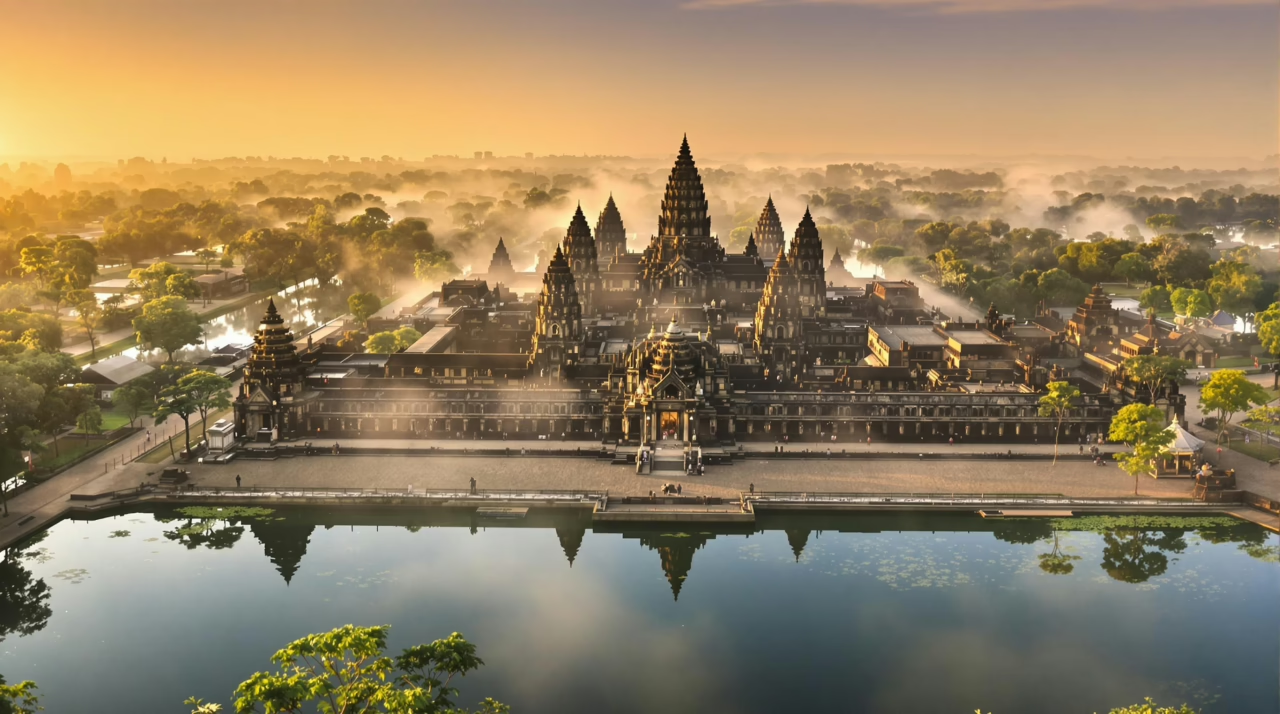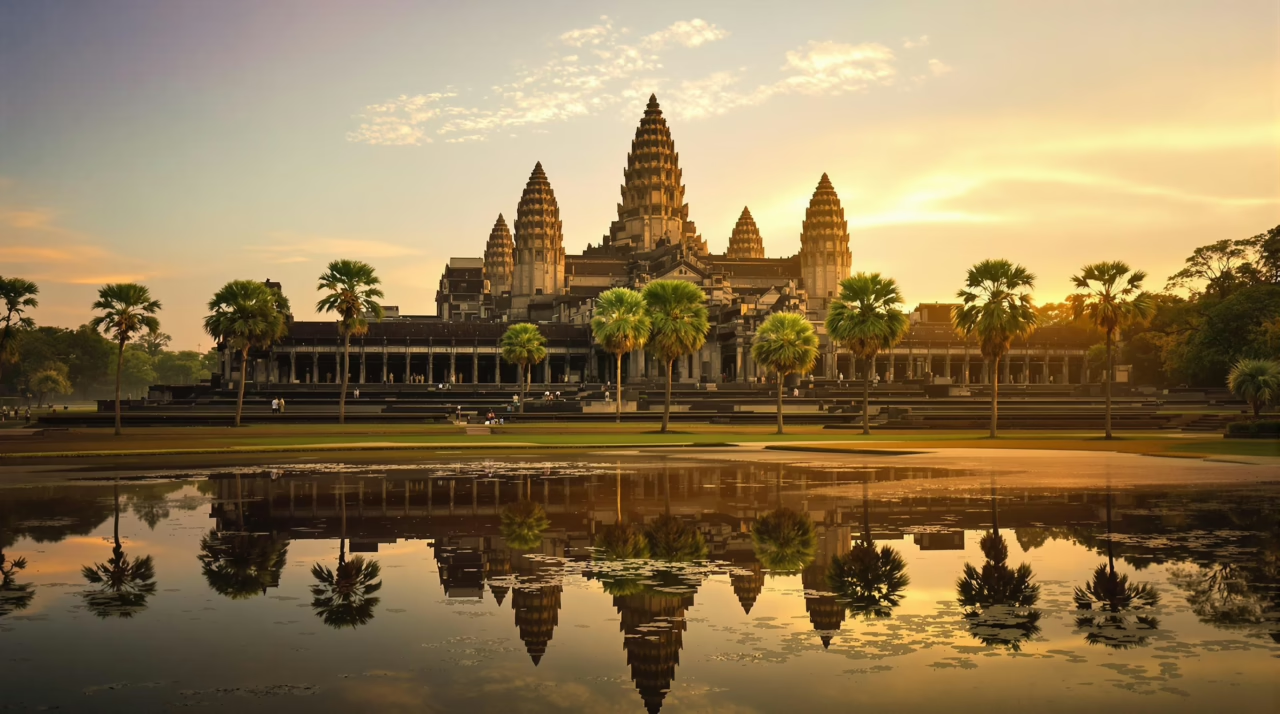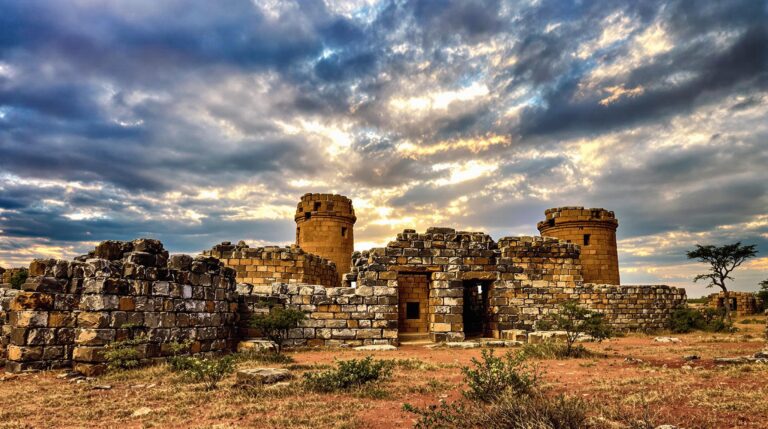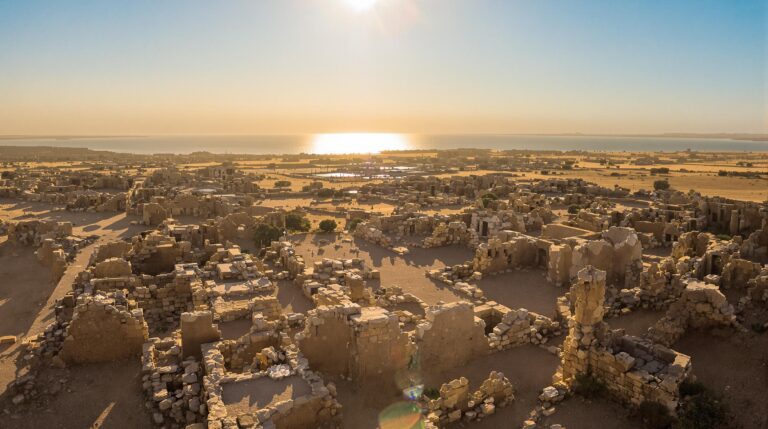Angkor Wat: Secrets of the Lost Empire

Angkor Wat stands as a monumental relic of the Khmer Empire, sparking curiosity about its origins and purpose.
The temple’s construction showcases remarkable engineering, yet many questions linger about its spiritual significance. Intricate carvings depict a blend of Hindu and Buddhist themes, hinting at a deeper narrative.
Recent discoveries suggest hidden chambers and lost rituals, inviting exploration of what secrets remain beneath its storied facade.
What truths could these revelations disclose about an empire long past?
TL;DR
Hide- Angkor Wat's construction reflects the Khmer Empire's engineering prowess, blending spirituality with innovative building techniques using locally sourced sandstone.
- Hidden chambers and unexplained passages within Angkor Wat suggest ancient rituals or royal treasures, raising questions about the builders' methods.
- The temple's intricate bas-reliefs encapsulate Khmer culture, intertwining Hindu and Buddhist beliefs, and showcasing the civilization's artistic mastery and values.
- Recent archaeological discoveries and advanced technologies, like 3D mapping, are unveiling secrets about Angkor Wat's origins and its complex water systems.
- Angkor Wat serves as a symbol of national pride for Cambodia, influencing global perceptions of Southeast Asian heritage while facing preservation challenges from tourism.
Historical Origins and Construction of Angkor Wat

The historical origins of Angkor Wat raise intriguing questions about the motivations behind its construction and the society that envisioned such a monumental structure.
How did the innovative building techniques employed by the Khmer architects reflect their understanding of engineering and spirituality?
Exploring these foundations reveals not only the architectural prowess of the time but also the cultural tapestry that shaped this iconic temple complex.
Foundation and Early History
The foundation of Angkor Wat is intricately linked to the birth of the Khmer Empire, a period steeped in both historical significance and legendary narratives.
What mythical inspirations guided the construction of this grand monument, and how did these stories shape its architectural grandeur?
Exploring these questions reveals a tapestry woven from ambition, spirituality, and cultural identity that defined a civilization.
Birth of the Khmer Empire
As the sun rose over the lush landscapes of Southeast Asia, the Khmer Empire began to take shape, laying the groundwork for one of history’s most remarkable architectural feats: Angkor Wat.
Emerging from the fusion of local traditions and Indian influences, the empire’s foundation was marked by ambitious irrigation projects and centralized leadership, reflecting a society driven by innovation, spirituality, and an enduring quest for sovereignty.
Legendary Inspirations and Mythical Beginnings
While the Khmer Empire was solidifying its power, the genesis of Angkor Wat emerged from a tapestry of legends and cultural narratives that intertwined the divine with the earthly.
This monumental structure stands as a hallmark to:
- The Hindu cosmology that inspired its design.
- King Suryavarman II’s ambitious vision.
- The fusion of artistry and devotion.
- The enduring myths surrounding its construction.
Innovative Building Techniques
The construction of Angkor Wat reveals a remarkable mastery of sandstone masonry, raising questions about the techniques employed by its builders.
How did the architects achieve such precise astronomical alignments in their design, seamlessly integrating spirituality with functionality?
Exploring these innovative building methods invites a deeper understanding of the Khmer civilization’s ingenuity and vision.
Mastery of Sandstone Masonry
Angkor Wat stands as a remarkable tribute to the mastery of sandstone masonry, a craft that reflects both the ingenuity and the cultural aspirations of the Khmer Empire.
This architectural marvel showcases:
- Precise stone-cutting techniques
- Advanced interlocking methods
- Use of locally sourced materials
- Innovative structural designs
These elements raise questions about the skills and knowledge that enabled such extraordinary construction, inviting deeper exploration.
Astronomical Alignments in Architectural Design
At the heart of Angkor Wat’s architectural brilliance lies a sophisticated understanding of astronomical alignments, which reveals the Khmer Empire’s profound connection to the cosmos.
This meticulous integration of celestial phenomena into design not only enhanced the temple’s spiritual significance but also showcased the builders’ innovative techniques.
Such alignments invite contemplation, prompting questions about the ancient civilization’s knowledge of astronomy and its influence on cultural identity.
Cultural and Spiritual Significance
The cultural and spiritual significance of Angkor Wat invites contemplation of its profound religious influences and intricate symbolism.
How do the artistic mastery and iconography reflect the beliefs and values of the society that constructed this monumental site?
Exploring these dimensions reveals not only the temple’s role as a sacred space but also its enduring impact on Cambodian identity.
Religious Influence and Symbolism
Angkor Wat stands as a remarkable showcase to the intertwining of Hindu and Buddhist beliefs, inviting contemplation on its rich spiritual tapestry.
The temple’s intricate iconography and sacred rituals evoke a profound sense of the divine, prompting an exploration of how these elements reflect the cultural identity of the Khmer civilization.
What hidden meanings and historical narratives might be uncovered within this architectural marvel’s religious symbolism?
Blend of Hindu and Buddhist Traditions
A confluence of faiths defines the spiritual landscape of Angkor Wat, where Hindu and Buddhist traditions intricately intertwine.
This unique blend raises intriguing questions about cultural identity and shared beliefs.
Key elements include:
- Architectural symbolism reflecting divine domains.
- Deities representing cosmic balance.
- Ritualistic practices merging philosophies.
- Iconography showcasing narratives of both faiths.
Such elements invite contemplation on spiritual unity and diversity.
Sacred Rituals and Divine Iconography
Numerous sacred rituals and intricate iconographic representations at Angkor Wat reveal deep layers of cultural and spiritual significance.
These ceremonies, steeped in symbolism, connect practitioners to divine domains, illustrating the interplay between earthly existence and transcendent beliefs.
The temple’s elaborate carvings, depicting deities and cosmic narratives, invite exploration of the complex relationship between spirituality and identity, reflecting the empire’s quest for divine favor and enlightenment.
Artistic Mastery and Iconography
Angkor Wat’s intricate bas-reliefs and sculptural details invite scrutiny into the narratives they convey, merging artistic finesse with profound cultural significance.
Each depiction reveals layers of myth and royal heritage, prompting questions about their role in shaping identity and spirituality within Khmer society.
How do these visual stories reflect the values and beliefs of a civilization that sought to transcend the earthly domain?
Intricate Bas-Reliefs and Sculptural Details
Intricate bas-reliefs and sculptural details of Angkor Wat stand as a tribute to the artistic mastery and spiritual significance of Khmer architecture.
These remarkable features invite exploration and reflection, prompting questions about their deeper meanings and cultural contexts.
Key aspects include:
- Symbolic narratives
- Iconographic elements
- Textural diversity
- Spiritual connections
What stories do they whisper to those who dare to listen?
Depictions of Myth and Royal Heritage
The depictions of myth and royal heritage within Angkor Wat‘s walls serve as a demonstration to the intertwining of cultural identity and spiritual belief in Khmer society.
Each intricate carving and vivid mural not only narrates epic tales but also immortalizes the lineage of kings, inviting reflection on the balance between power and divinity.
Ultimately, this enriches the viewer’s understanding of a civilization that sought eternal significance.
Unsolved Mysteries and Modern Discoveries
The grandeur of Angkor Wat conceals numerous architectural enigmas and hidden spaces that continue to baffle historians and archaeologists alike.
Recent archaeological breakthroughs have unearthed tantalizing clues, yet many questions remain unanswered, leaving the temple’s origins shrouded in mystery.
What secrets do these ancient stones hold, and how might modern technology reveal the past?
Architectural Enigmas and Hidden Spaces
Angkor Wat, a marvel of ancient engineering, harbors secret chambers and unexplained passages that continue to baffle historians and archaeologists alike.
The precision of its construction, achieved without modern tools, raises questions about the techniques employed by its creators.
What mysteries lie hidden within its walls, waiting to be uncovered?
Secret Chambers and Unexplained Passages
While many marvel at the grandeur of Angkor Wat‘s exterior, whispers of secret chambers and unexplained passages intrigue those who investigate deeper into its architectural mysteries.
These enigmatic spaces invite curiosity and speculation:
- Hidden sanctuaries for spiritual rituals
- Uncharted tunnels connecting structures
- Concealed vaults for royal treasures
- Mysterious carvings hinting at lost knowledge
Each discovery fuels the desire for answers and freedom from historical obscurity.
Precision Construction Without Modern Tools
Remarkably, the precision with which Angkor Wat was constructed raises questions that both historians and engineers grapple with today.
How did the ancient Khmer builders achieve such alignment and scale without modern tools? This enigma invites exploration into their techniques, materials, and knowledge of mathematics, suggesting a level of innovation and craftsmanship that challenges contemporary understanding of architectural capabilities in the absence of advanced technology.
Archaeological Breakthroughs
Recent advancements in remote sensing and 3D mapping have opened new avenues for understanding Angkor Wat’s complex history.
These innovative techniques promise to shed light on previously overlooked structures and cultural practices, inviting fresh interpretations of existing historical data.
As researchers harness modern technology, intriguing questions arise about the ancient civilization’s ingenuity and the mysteries that still linger beneath the surface.
Remote Sensing and 3D Mapping Innovations
As researchers explore deeper into the mysteries of Angkor Wat, the application of remote sensing and 3D mapping technologies has emerged as a transformative force in archaeology.
These innovations offer unprecedented insights, enabling scholars to:
- Reveal hidden structures beneath dense vegetation.
- Map ancient water systems.
- Analyze site layouts with precision.
- Foster collaboration across global research communities.
Such advancements spark curiosity about the empire’s enigmatic past.
New Interpretations of Historical Data
While the remnants of Angkor Wat continue to captivate scholars and enthusiasts alike, the reinterpretation of historical data has unearthed a wealth of insights that challenge long-held assumptions about the Khmer Empire.
Recent discoveries, including advanced agricultural techniques and trade networks, suggest a society not merely focused on grandeur, but one thriving on innovation and adaptability.
This invites deeper exploration into its enigmatic legacy.
Legacy and Global Impact
The legacy of Angkor Wat extends far beyond its ancient stones, serving as a crucial symbol of national pride for Cambodia.
How has its preservation influenced contemporary cultural identity and inspired modern tourism practices?
Furthermore, what role does this iconic monument play in shaping global perceptions of Southeast Asian heritage?
Preservation and National Pride
The ongoing restoration efforts at Angkor Wat raise important questions about the intersection of cultural heritage and national identity in Cambodia.
As this iconic temple complex stands as a symbol of the nation’s history and resilience, what implications do these preservation initiatives hold for Cambodian pride on the global stage?
Exploring the balance between safeguarding the past and fostering a collective identity invites a deeper understanding of Angkor Wat’s lasting legacy.
Restoration Efforts and Cultural Heritage Initiatives
As efforts to restore Angkor Wat gain momentum, questions arise about the long-term implications for Cambodia’s cultural heritage and national identity.
What impact do these initiatives have on preservation? Consider the following:
- Balancing modernization with tradition.
- Community involvement in restoration processes.
- International collaboration and its effects.
- Economic benefits versus cultural authenticity.
Each factor intertwines, shaping the future of this iconic site.
Angkor Wat as a Symbol of Cambodian Identity
Angkor Wat stands not only as a remarkable architectural achievement but also as a profound emblem of Cambodian identity, encapsulating the nation’s history, spirituality, and resilience.
This intricate monument invites contemplation of its role in fostering national pride and unity.
How does its preservation reflect Cambodia’s aspirations?
In a global context, can Angkor Wat serve as a beacon for cultural identity and freedom?
Influence on Modern Culture and Tourism
The majestic grandeur of Angkor Wat has not only captivated the imaginations of travelers but has also permeated modern art, film, and literature, shaping creative expressions across cultures.
As tourism flourishes around this iconic site, one must consider the economic and social transformations it spawns within Cambodia and beyond.
What are the broader implications of this cultural exchange, and how does it redefine the legacy of Angkor Wat in today’s global landscape?
Inspiration for Art, Film, and Literature
While many historical sites inspire creativity, few possess the profound impact of Angkor Wat on art, film, and literature.
Its majestic architecture and enigmatic history serve as a muse for creators worldwide. Notable influences include:
- Iconic scenes in films like “Lara Croft: Tomb Raider.”
- Evocative poetry reflecting its beauty.
- Intricate artworks capturing its grandeur.
- Documentaries exploring its mysteries.
Angkor Wat endures as a timeless source of inspiration.
Economic and Social Benefits Through Tourism
As visitors flock to the storied ruins of Angkor Wat, the economic and social ramifications of this influx become increasingly evident.
Local businesses thrive, creating jobs and fostering community development.
However, the delicate balance between preserving cultural heritage and accommodating tourism raises questions about sustainability.
Can this ancient site endure the weight of modern expectations while continuing to inspire freedom and exploration?
Wrapping Up
In the shadow of its towering spires, Angkor Wat remains a fascinating enigma, inviting exploration of its ancient secrets.
Each stone whispers tales of a civilization that fused spirituality and artistry, yet many mysteries linger, like echoes of a forgotten past.
As modern discoveries reveal hidden truths, the allure of this architectural marvel only deepens, urging both scholars and wanderers to ponder the lost knowledge of the Khmer Empire and its enduring legacy on the world stage.





